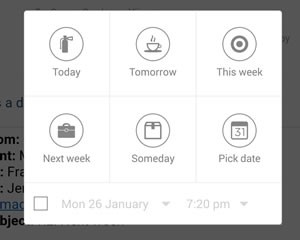I was told recently by a senior DFID official that my greatest contribution to DFID so far has been my system for managing email overload, which apparently has been widely adopted there. (I’d like to think he was joking, but I fear not.)
If you missed my previous (2012) post about managing email, here is a summary.
Without wanting to sound smug, I normally have zero inbox. I achieve this by triaging my inbox several times a day into three categories: (a) I deal immediately with anything that can be answered in a few minutes; (b) things that will take longer, I defer to the day on which I plan to do it; and (c) I file the things that need no further action. Then I leave my (empty) inbox and look at my Today folder, which contains the things that I have previously tagged to deal with today. If I triage two or three times a day, I can keep my inbox at zero and focus on the work I should be doing today. The great thing about this is that my inbox is no longer my to-do list, and I don’t find myself scrolling through the same items in my inbox time and time again.
This system can be implemented in Microsoft Outlook without having to install any additional software – and here is the (updated) guide on how to set it up and use it which discusses in more detail how to work it. (Though I’m not wild about Microsoft, I think Outlook is pretty good, and anyway it is forced on people in most offices.)
Over the last couple of years since my last blog post on this, I’ve refined the system a little, in three ways. These refinements all require additional software (unlike the basic system) so you may not be able to implement these bells and whistles on your office computer if your system administrators are finickity. That’s OK: it still works fine without them. Here are the three additions I’ve made.

Refinement one: I now use Nine as the email client on my Android phone. In Nine I can triage on the go. It can flag emails in a way that is Outlook-compatible: so I can triage my mail in the coffee shop or on the bus, and I’ll have nothing in my inbox when I fire up Outlook on my laptop. Nine costs $9.99 – money well spent as far as I am concerned.
Refinement two: I have installed SimplyFile, an Outlook add-on which does what it says on the tin. It massively speeds up filing of emails into the correct folder – because SimplyFile works out (usually correctly) where I am likely to want to file my mail (based on where I have put previous emails with similar characteristics). It creates a big button in Outlook to file mail in the folder it has identified. It also offers a drop down list of likely alternative folders in case it hasn’t got it right and it also has a very quick facility to find a folder by name (even if the folder is several layers deep). Though it sounds trivial, SimplyFile saves me a lot of time. You can try it free for 30 days – it took me only a couple of days to decide that it was well worth the $50 for a licence. (I know: $50 is not trivial. Try SimplyFile first and see if you agree that it is worth it before you splash out.) Annoyingly if you want to use SimplyFile on more than one computer, you’ll need to buy a separate licence for each machine.
Refinement three: My team has gone over to using Slack for internal collaboration. You may not be thrilled by the thought of yet another piece of software, but I have never seen software so rapidly and easily adopted in the workplace. This has significantly reduced my email inbox, because all the ephemera (“who is coming out for lunch?”, “the meeting is starting now in the boardroom”) is now all in Slack. My team sends about 2,000 slack messages a week: those are almost all messages that would previously have been sent by email. We use the free version in my office – and it works fine on PC, Mac, IOS and Android.
If this sounds worth trying – with or without the refinements – then here is the guide on how to set it up and use it.
If you have a better way of managing your email deluge (or just a different approach), please share your suggestions in the comments below.






9 responses to “Zero inbox – an update”
I know it can’t be used for professional email addresses yet, but what are you thoughts about Inbox by Google which has integrated the option to snooze your emails by time/date?
Unfortunately my Gmail is in a Google Apps account, so I haven’t yet tried Inbox. It sounds great though.
Inbox is good (in beta though) but it is just a copy of Mailbox (kind of). Have you tried that?
I haven’t. My office uses Exchange server, which Mailbox does not yet support. I’m pretty happy with Outlook, I have to say.
I use the standard Apple mail client on my mac but process email using a similar system to yours. On a regular basis I either deal with the email or move it into OmniFocus (https://www.omnigroup.com/omnifocus/). With OmniFocus you can clip messages into the client (it saves with a unique URL that will open the message in the mail application later) and then add metadata to it like due dates. The advantage of this over many others systems is consolidation, in that OmniFocus also lets you manage all of your other tasks. I’ve been using it in some form since 2007, through all my PhD and into my first “real” job, and it has been excellent. However, it is restricted to the OS X/iOS ecosystem.
Nice system! I try to apply a similar one to my often overflowing inbox, but I can never seem to keep up. I’ll look into the apps you recommended for refinement, as well. Maybe it’ll help!
Thanks for your post! Any chance you have any insight on how to set this up on a Mac? It seems that outlook has a different search folder format on Outlook for Mac. Thanks!
Bravo on the spruced up blog, and further congratulations on including the incredibly corny “Lawnmower Man-esque” image at the top of this post. 🙂
I use your Outlook email managing method for 4 years now and find it extremely useful.
Thanks again!
I also believe that we should progressively find ways to replace email by new communication tools, especially for internal communication, either through instant messaging or through message boards with good search functions.